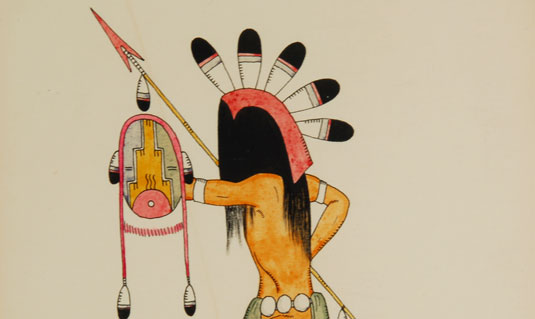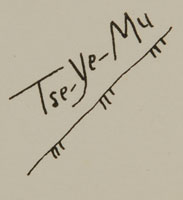Comanche Dancer with Avanyu [SOLD]
+ Add to my watchlist Forward to Friend
- Category: Paintings
- Origin: San Ildefonso Pueblo, Po-woh-ge-oweenge
- Medium: casein
- Size: 10-3/8” x 6-3/4” image;
16-1/4” x 12-5/8” framed - Item # C3808C SOLD
Romando Vigil was one of the San Ildefonso self-taught artists in the early part of the 20th century. He was a leader within the San Ildefonso Watercolor Movement, a movement that caught fire during 1915 to 1917. It fostered an art form unmatched in the culture history of the world. These men portrayed tribal culture and local wildlife, attaining a flat decorative character, absent of backgrounds and foregrounds, and free of traditional perspective, with an unerring color sense. Their success in these presentations was due to their understanding the ceremonials they painted because they had participated in them since childhood. They understood the meanings of the symbolism they interpreted.
San Ildefonso Pueblo members dance the Comanche Dance every year on January 23rd, which is the pueblo’s feast day. The peaceful Pueblo Indians of New Mexico and Arizona never wore feathered headdresses popular with tribes believing in the virtue of warfare. The Navajo, Apache, Ute and Comanche were the ones who raided the pueblos.
San Ildefonso Pueblo celebrates the Comanche Dance to honor the end of hostilities between the tribes and their peaceful co-existence. The dancers have painted faces, wear a feathered head bonnet, and some carry a flag that has meaning in Plains Indian custom; a warrior proved his valor by planting his flag in the ground during battle, tied himself to it, and defended it to the death against all-comers. He earned a feather bonnet after accomplishing this feat.
In this painting, the warrior carries a spear and shield and it is possible that the Avanyu is meant as a protector of the warrior.
This painting was executed with paints on stiff paper. It is framed in a vintage wood frame which may be the original frame. It is signed by the artist Tse-Ye-Mu in lower right.
Condition: appears to be in good condition but may have some faint acid burn around the edge of the mat
Provenance: from the collection of a family from upstate New York.
Recommended Reading: Southwest Indian Painting: A Changing Art by Clara Lee Tanner

- Category: Paintings
- Origin: San Ildefonso Pueblo, Po-woh-ge-oweenge
- Medium: casein
- Size: 10-3/8” x 6-3/4” image;
16-1/4” x 12-5/8” framed - Item # C3808C SOLD




